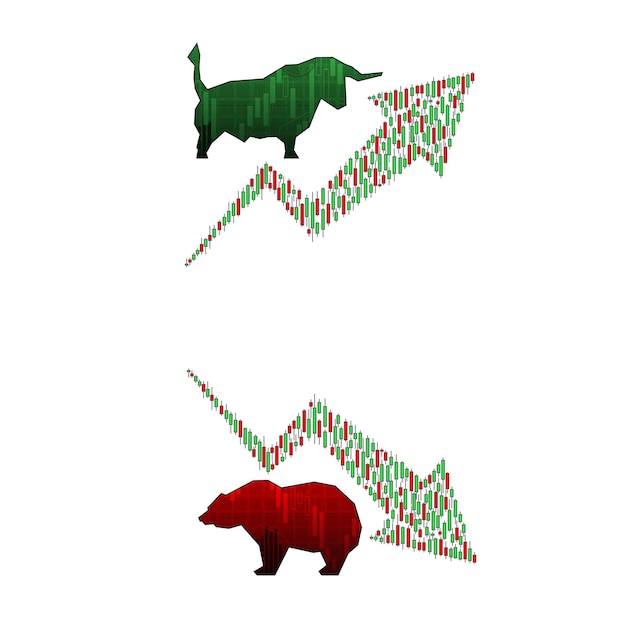Inverse ETFs: A Complete Guide to Hedging Your Portfolio

Understanding and Utilizing Inverse ETFs: A Guide to Hedging Your Portfolio in Uncertain Markets involves using exchange-traded funds that are designed to profit from a decline in an underlying index or asset, offering investors a way to potentially mitigate losses during market downturns.
Navigating the stock market can feel like traversing unpredictable terrain, especially when volatility spikes. **Understanding and Utilizing Inverse ETFs: A Guide to Hedging Your Portfolio in Uncertain Markets** provides invaluable tools for any investor looking to protect their assets; let us explore the ways these funds can defend your investments against market downturns.
Understanding Inverse ETFs
Inverse ETFs, also known as bear ETFs, are designed to move in the opposite direction of a specific market index or sector. This means that if the S&P 500 drops by 1%, an inverse S&P 500 ETF should rise by approximately 1%. Understanding their function is crucial before integrating them into your investment strategy.
How Inverse ETFs Work
Inverse ETFs achieve their objective through the use of derivatives such as futures contracts, options, and swaps. These instruments allow the fund to effectively short the underlying index or asset, enabling it to profit from a decline in value.
Leveraged vs. Non-Leveraged Inverse ETFs
It’s important to distinguish between leveraged and non-leveraged inverse ETFs. Leveraged inverse ETFs aim to magnify the inverse return, often by a factor of two or three. While this can lead to higher profits in the short term, it also amplifies losses and increases the risk of significant capital erosion, especially over longer periods.
- Non-Leveraged Inverse ETFs: Designed to deliver the inverse of the daily performance of the underlying index.
- Leveraged Inverse ETFs: Aim to deliver two or three times the inverse of the daily performance, amplifying both gains and losses.
- Compounding Effect: Daily resets can lead to significant discrepancies between the ETF’s performance and the inverse performance of the underlying index over longer time horizons.
In conclusion, understanding how inverse ETFs function, particularly the difference between leveraged and non-leveraged options, forms the bedrock of responsible utilization. This knowledge empowers investors to make informed decisions aligning with their risk tolerance and investment objectives.

Benefits of Using Inverse ETFs for Hedging
Hedging your portfolio involves taking strategic positions to offset potential losses. Inverse ETFs offer a straightforward way to hedge against short-term market declines without having to individually short stocks, which can be complex and costly.
Mitigating Portfolio Risk
By allocating a portion of your portfolio to inverse ETFs, you can create a buffer against market downturns. If your long positions decline in value, the inverse ETF should increase, partially offsetting those losses.
Short-Term Hedging Strategy
Inverse ETFs are particularly effective for short-term hedging strategies. They allow investors to quickly react to market signals and adjust their portfolio exposure accordingly. However, they are generally not recommended for long-term investments due to the effects of compounding and daily resets.
- Cost-Effective: Often more cost-effective than shorting individual stocks.
- Flexibility: Allows for quick adjustments to portfolio exposure.
- Accessibility: Easily accessible through standard brokerage accounts.
In summary, the benefits of inverse ETFs in hedging include risk mitigation, cost-effectiveness and increased flexiblity. Using them provides investors with essential tools to manage market exposure with added efficiency.
Risks and Considerations of Inverse ETFs
While inverse ETFs can be useful hedging tools, they are not without risks. Understanding these risks is crucial before incorporating inverse ETFs into your investment strategy.
Compounding and Daily Resets
One of the primary risks of inverse ETFs is the effect of compounding and daily resets. Due to the way these funds are structured, their performance over periods longer than a day can deviate significantly from the inverse performance of the underlying index.
Volatility and Expense Ratios
Inverse ETFs can be highly volatile. Leveraged inverse ETFs are even more so. Additionally, inverse ETFs tend to have higher expense ratios compared to traditional ETFs, which can eat into returns over time.
Not for Long-Term Investments
Due to compounding, daily resets, and higher expense ratios, inverse ETFs are generally not suitable for long-term investments. They are best used as short-term hedging tools.

- Compounding Effect: Can lead to significant discrepancies between the ETF’s performance and the inverse performance of the underlying index over longer time horizons.
- Volatility Risk: Higher volatility can lead to substantial losses, especially with leveraged ETFs.
- Expense Ratios: Higher expense ratios can reduce overall returns.
In conclusion, utilizing inverse ETFs requires a thorough awareness of their risks, especially with compounding effects and volatility. Recognizing those challenges helps fine-tune strategies for their application.
How to Choose the Right Inverse ETF
Selecting the right inverse ETF requires careful consideration of your investment objectives, risk tolerance, and the specific market segment you wish to hedge. Not all inverse ETFs are created equal, and choosing the wrong one can lead to disappointing results.
Evaluate the Underlying Index
Start by evaluating the underlying index or asset that the inverse ETF is designed to track. Ensure that it aligns with your hedging needs and that you understand its historical performance and volatility characteristics.
Consider Leverage and Expense Ratios
Pay close attention to the leverage factor and expense ratio of the inverse ETF. Leveraged ETFs can amplify both gains and losses, so they are best suited for experienced investors with a high risk tolerance. Lower expense ratios can improve your overall returns over time.
Read the Fund Prospectus
Always read the fund prospectus before investing in an inverse ETF. The prospectus contains important information about the fund’s investment objectives, strategies, risks, and expenses.
Choosing the right inverse ETF for your requirements involves evaluating the underlying index along with fund structure and leverage. Fully understanding fund specifics is crucial to aligning the investment with your goals.
Strategies for Using Inverse ETFs in Your Portfolio
Effectively integrating inverse ETFs into your portfolio requires a well-thought-out strategy. These funds are best used as tactical tools for short-term hedging, rather than as buy-and-hold investments.
Determine Your Hedging Needs
Before investing in inverse ETFs, determine your specific hedging needs. Identify which parts of your portfolio are most vulnerable to market declines and how much downside protection you require.
Set Stop-Loss Orders
Given the volatility of inverse ETFs, it’s wise to set stop-loss orders to limit potential losses. This can help prevent a small hedging position from turning into a significant drag on your portfolio.
Rebalance Regularly
Regularly rebalance your portfolio to maintain your desired asset allocation. As inverse ETFs are designed for short-term use, you may need to adjust your position more frequently than with other investments.
- Hedging Needs: Understanding which parts of the portfolio need downside protection.
- Stop-Loss Orders: Essential for limiting potential losses due to volatility.
- Regular Rebalancing: Necessary to maintain the desired asset allocation.
Effectively using inverse ETFs hinges on strategy and monitoring. Setting stop-loss orders and rebalancing regularly are crucial in managing risk and maintaining your portfolio’s equilibrium.
Real-World Examples of Inverse ETF Usage
To illustrate how inverse ETFs can be used in practice, let’s look at a couple of real-world examples. These examples demonstrate how investors can use inverse ETFs to protect their portfolios during market downturns.
Hedging During Earnings Season
Suppose you own a portfolio of technology stocks and are concerned about the potential for negative surprises during earnings season. You could purchase an inverse technology ETF to hedge against a sector-wide decline.
Protecting Against Market Corrections
If you believe that the overall market is overvalued and ripe for a correction, you could allocate a small portion of your portfolio to an inverse S&P 500 ETF. This would provide some downside protection if the market declines.
Examples help to clarify the functional application of using inverse ETFs. They are tools for specific scenarios instead of overarching long plays.
| Key Point 🔑 | Brief Description 📝 |
|---|---|
| 📉 Inverse ETFs | Funds that profit from market declines, offering portfolio hedging. |
| ⚠️ Risks | Include compounding, volatility, and higher expense ratios. |
| 🎯 Strategies | Short-term tactical tools, requiring stop-loss orders and rebalancing. |
| ✅ Benefits | Effective for mitigating short-term risks and adjusting portfolio exposure. |
Frequently Asked Questions (FAQs)
▼
Inverse ETFs are designed to provide returns that are the inverse of a specific index or asset. They achieve this by using derivatives, such as futures contracts and options, to short the underlying asset, thus profiting from its decline.
▼
No, inverse ETFs are generally not recommended for long-term investments. The daily reset feature and compounding effects can cause their performance to deviate significantly from the inverse of the underlying index over time.
▼
The main risks include compounding effects, high volatility, and potentially higher expense ratios compared to traditional ETFs. Leveraged inverse ETFs can amplify these risks, making them even more volatile and prone to significant losses.
▼
You can use inverse ETFs to hedge your portfolio by allocating a portion of your investments to them. If the market declines, the inverse ETF should increase in value, offsetting some of the losses in your long positions, providing a balanced strategy.
▼
When choosing an inverse ETF, consider the underlying index, leverage factor, expense ratio, and your risk tolerance. Also, always read the fund prospectus to understand the fund’s investment objectives, strategies, risks, and expenses thoroughly.
Conclusion
In conclusion, understanding and utilizing inverse ETFs: a guide to hedging your portfolio in uncertain markets effectively provides tools for navigating uncertain market conditions. By understanding their mechanics, risks, and appropriate strategies, investors can implement these tools for managing risks and protecting gains.





